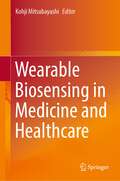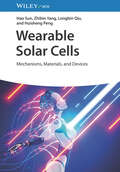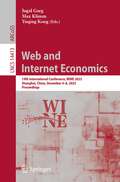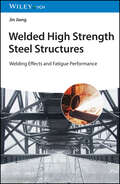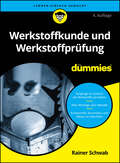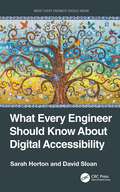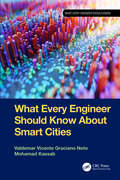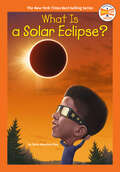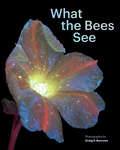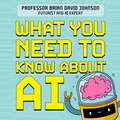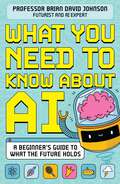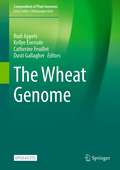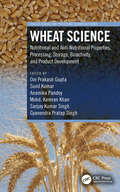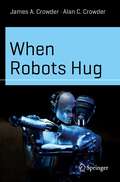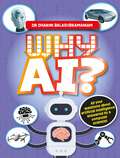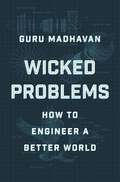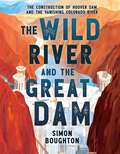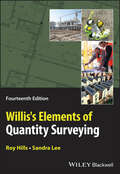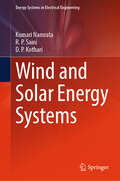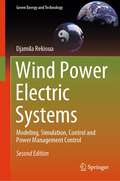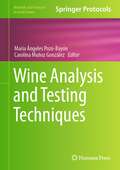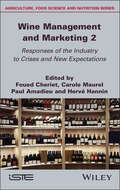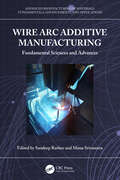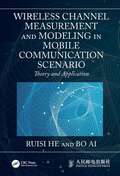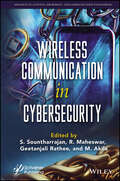- Table View
- List View
Wearable Biosensing in Medicine and Healthcare
by Kohji MitsubayashiThis book contains chapters on wearable biomedical sensors and their assistive technologies for promoting behavioral change in medical and health care. Part I reviews several wearable biomedical sensors based on biocompatible materials and nano and micro-electromechanical systems (MEMS) technologies in the medical and dental fields. Part II introduces the latest approaches to wearable biosensing using unique devices for various skin targets such as sweat, interstitial fluid, and transcutaneous gases. Part III presents technologies supporting wearable sensors, including soft and flexible materials, manufacturing methods, skin volatile-marker imaging, and energy harvesting devices.This book is intended for graduate students, academic researchers, and professors that work in medical and healthcare research fields, as well as industry professionals involved in the development of wearable and flexible sensing devices and measurement systems for human bio/chemical sensing, medical monitoring, and healthcare services, and for medical professionals and government officials who are driving behavior change in health care.
Wearable Solar Cells: Mechanisms, Materials, and Devices
by Hao Sun Zhibin Yang Longbin Qiu Huisheng PengWearable Solar Cells Understand a groundbreaking new energy technology Solar energy is one of the most important paths to a sustainable future. In recent years, extensive research and development has begun to produce wearable solar cells, whose novel planar and fiber format gives them enormous flexibility and a wide range of potential uses. The possibility of a solar energy source that can be fitted to the human body promises to become an extraordinary tool for meeting various kinds of personal energy needs. Wearable Solar Cells: Mechanisms, Materials, and Devices serves as a comprehensive introduction to this cutting-edge technology and its applications. Recent research pointing towards fiber-format solar cells as a bold new frontier is summarized and explored. The result is an essential resource for both experienced researchers and newcomers to the field. Wearable Solar Cells readers will also find: Close coverage of integrated energy harvesting and storage devices Detailed discussion of dye-sensitized solar cells, polymer solar cells, perovskite solar cells, and more An authorial team with decades of combined research experience Wearable Solar Cells is ideal for materials scientists, polymer chemists, electrical engineers, solid-state physicists, and advanced students interested in these and related topics.
Web and Internet Economics: 19th International Conference, WINE 2023, Shanghai, China, December 4–8, 2023, Proceedings (Lecture Notes in Computer Science #14413)
by Jugal Garg Max Klimm Yuqing KongThis volume LNCS 14413 constitutes the refereed proceedings of the 19th International Conference, WINE 2023, in December 2023 held in Shanghai, China. The 37 full papers presented together with 29 one-page abstracts were carefully reviewed and selected from 221 submissions. The WINE conference series aims to exchange research ideas in a diverse area of application at the intercept of theoretical computer science , artificial intelligence, operations research, and economics.
Welded High Strength Steel Structures: Welding Effects and Fatigue Performance
by Jin JiangWelded High Strength Steel Structures Understand the impact of fatigue on high strength steel joints with this comprehensive overview High strength steels are highly sought after for industrial and engineering applications ranging from armored vehicles to welded engineering components built to withstand considerable stress. The mechanical properties of welded joints made from high strength steel are integrally linked to the specific welding process, which can have an enormous impact on fatigue performance. Welded High Strength Steel Structures: Welding Effects and Fatigue Performance provides a comprehensive analysis of high strength steel joints and the ramifications of the welding process. It guides readers through the process of performing thermal analysis of high strength steel structures and evaluate fatigue performance in the face of residual stress. The result is a volume with innumerable use cases in engineering and manufacture. Welded High Strength Steel Structures readers will also find: An author with decades of experience in research and engineering Numerous studies of various classes of high strength steel joints Studies on tubular structures for welding residual stress Welded High Strength Steel Structures is a must-own for welding specialists, materials scientists, mechanical engineers, and researchers or industry professionals in related fields.
Werkstoffkunde und Werkstoffprüfung für Dummies (Für Dummies)
by Rainer SchwabDrum prüfe, wer den Werkstoff findet Werkstoffkunde und Werkstoffprüfung sind für viele Studierende eher Pflicht als Leidenschaft. Rainer Schwab zeigt Ihnen, dass es auch anders geht: Mit Humor und Präzision, mit einfachen Erklärungen und passenden Beispielen erklärt er Ihnen in dieser aktualisierten Auflage die Werkstoffkunde und Werkstoffprüfung so spannend es nur geht. Von den Grundlagen zieht sich der Bogen über die Prüfmethoden hin zu den wichtigen konkreten Werkstoffen und Wärmebehandlungen. So ist dieses Buch das Rundumwohlfühlpaket für jeden, der sich mit dem Thema beschäftigt. Sie erfahren Was die wichtigen Eigenschaften der Werkstoffe sind Wie Sie Härteprüfungen, Zugversuche und Co. richtig durchführen Warum Eisen und Stahl so vielfältig sind Welche wichtigen Werkstoffe es gibt, die nicht aus Eisen sind
What Every Engineer Should Know About Digital Accessibility (ISSN)
by Sarah Horton David SloanAccessibility is a core quality of digital products to be deliberately addressed throughout the development lifecycle. What Every Engineer Should Know About Digital Accessibility will prepare readers to integrate digital accessibility into their engineering practices. Readers will learn how to accurately frame accessibility as an engineering challenge so they are able to address the correct problems in the correct way.Illustrated with diverse perspectives from accessibility practitioners and advocates, this book describes how people with disabilities use technology, the nature of accessibility barriers in the digital world, and the role of engineers in breaking down those barriers. Accessibility competence for current, emerging, and future technologies is addressed through a combination of guiding principles, core attributes and requirements, and accessibility‑informed engineering practices.FEATURES Discusses how technology can support inclusion for people with disabilities and how rigorous engineering processes help create quality user experiences without introducing accessibility barriers Explains foundational principles and guidelines that build core competency in digital accessibility as they are applied across diverse and emerging technology platforms Highlights practical insights into how engineering teams can effectively address accessibility throughout the technology development lifecycle Uses international standards to define and measure accessibility quality Written to be accessible to non‑experts in the subject area, What Every Engineer Should Know About Digital Accessibility is aimed at students, professionals, and researchers in the field of software engineering.
What Every Engineer Should Know About Smart Cities (What Every Engineer Should Know)
by Valdemar Vicente Neto Mohamad KassabGet ready to be at the forefront of the future of urban development! As cities continue to rapidly grow, the demand for sustainable and efficient infrastructure becomes more urgent. That’s where What Every Engineer Should Know About Smart Cities comes in, offering a comprehensive guide to the concepts and technologies driving the transformation of our cities. Delve into the world of smart cities and discover how information and communication technologies are revolutionizing urban environments. With clear definitions and a focus on real-world applications, this book explores the benefits and challenges of smart cities. It also highlights interdisciplinary topics such as smart buildings, autonomous cars, and urban emergency management systems. This book is not just a theoretical exploration of smart cities. It goes beyond that by providing an in-depth look at the key technologies that are essential to creating smart cities. From the Internet of Things and blockchain to digital twins and modeling and simulations, readers will gain a solid understanding of the foundational technologies that make smart cities possible. With detailed discussions and real-world examples of smart mobility, smart health, smart education, and smart agribusiness, readers will gain a deep understanding of the requirements and characteristics that engineers need to contribute to the development of smart cities. Whether you’re an engineer looking to expand your knowledge, a city planner seeking to understand the latest trends, or simply someone interested in the future of urban living, What Every Engineer Should Know About Smart Cities is the ultimate guide to unlocking the potential of smart cities for sustainable urban development and improved quality of life.
What Is a Solar Eclipse? (Who HQ Now)
by Dana Meachen Rau Who HQLearn about the phenomenon of a solar eclipse just in time for the Great American Eclipse that will take place on April 8, 2024 in this title in the Who HQ Now series featuring newsmakers and trending topics.Just in time for the third North American total solar eclipse of the twenty-first century, this book explains how to safely observe solar eclipses, how long eclipses last, and why they result in a blackout period during the day. Young armchair astronomers and astronauts will be inspired by the wonders of outer space and what exists beyond our atmosphere as they learn more about the moon, the sun, and our earth. What really happens during a solar eclipse and how does it affect the energy in our atmosphere? You'll find the most up-to-date eclipse information in this exciting new book.
What the Bees See
by Craig P. BurrowsDiscover the magical world of the honeybee with this deluxe book, featuring 70 stunning images shot with ultraviolet technology.A comprehensive look into the amazing science of bees, this book collects mesmerizing ultraviolet-induced visible fluorescence (UVIVF) photography of flowers and nature and offers fascinating research that explores every aspect of our relationship with honeybees. Learn about the history of beekeeping, current environmental impacts affecting bees, and the rise of bee products in medical and wellness spaces. As you travel through the world of bees, you'll discover a diverse range of flora showcased in a whole new light through the ultraviolet spectrum, from orchids and anemones to manuka and cactus blossoms. A gorgeous gift for environmentalists and photography fans alike, this in-depth book invites us to reimagine the world from a bee's point of view and better understand its importance to the future of all life on earth.PHENOMENAL NATURE IMAGERY: Craig P. Burrows has been specializing in UVIVF photography for nearly a decade, and this book includes 70 incredible photos taken using this innovative technique. Burrow's luminescent images capture the magic of nature and showcase flowers glowing in otherworldly blues and teals, simulating how bees and other pollinators become attracted to the plants.GET THE BUZZ ABOUT BEES: In addition to the incredible UV photography, this book features engaging illustrations and infographics, archival and historical images, and original interviews with over forty of the world’s leading experts on bees and bee products. Organized into three distinct sections on bee ecosystems, bee products and cultivation, and modern medical and wellness advances tied to bees, this in-depth book illuminates the extraordinary role the honeybee has played throughout history and will answer questions you didn’t even know you had.SUSTAINABILITY GIFT BOOK: This deluxe photobook is a great gift for nature lovers, bee and beekeeping enthusiasts, and anyone who cares about environmental conservation and preservation. Add it to the shelf with books like the National Geographic Photo Ark series by Joel Sartore and DK's The Bee Book.Perfect for:Bee, insect, and bug enthusiastsNature lovers and environmental activistsFlower and nature photography loversPeople interested in learning about bee products used in medicine, wellness, and skincare People interested in UVIVF technology and innovative photography techniquesFans of nature documentaries like David Attenborough’s Life In Color seriesFans of Craig P. Burrows's research and photography
What You Need to Know About AI: A beginner’s guide to what the future holds
by Brian David JohnsonThe only book you need on AI - for all curious, fact-gobbling kids age 7+.What actually is AI? Will it take over the world? And one day, will it tidy your bedroom...? In this beginner's guide, learn everything you need to know about AI, from how it helps us discover epic stuff up in space or under the sea, whether it will help you build your very own dinosaur, and why, it won't actually help you write your homework! Written by AI expert and Futurist, Brian David Johnson, you will learn what AI is, where it came from, and how it's already being used in the world of sport, space, medicine, animals and more. You will discover AI's amazing possibilities that might shape the future. And along the way, you'll learn super cool facts, bust some myths, and gain a balanced and informed view on the biggest topic of our time.Designed with fun line illustrations throughout.
What You Need to Know About AI: A beginner’s guide to what the future holds
by Brian David JohnsonThe only book you need on AI - for all curious, fact-gobbling kids.What actually is AI? Will it take over the world? And one day, will it tidy your bedroom . . .? In this beginner's guide, learn everything you need to know about AI, from how it helps us discover epic stuff up in space or under the sea to whether it might help you build your own dinosaur.With AI expert and futurist Brian David Johnson, discover what AI is, where it came from, the incredible ways it's being used today and how it might shape and reimagine your future. Learn that AI is just software and that it won't replace human creativity or imagination, but it could help us do some really cool things. And uncover amazing facts, myth busters and insight from experts around the world!This book offers a balanced, expert and fascinating view on the biggest topic of our time. Designed with fun illustrations throughout.
The Wheat Genome (Compendium of Plant Genomes)
by Rudi Appels Kellye Eversole Catherine Feuillet Dusti GallagherThis open access book provides the first comprehensive coverage of the wheat genome sequence since the publication of the draft and reference sequences for bread wheat and durum wheat. It presents an overview and all aspects of the gold standard sequence of the bread wheat genome, IWGSC RefSeq v1.0 and its subsequent improvements through 2022 (IWGSC RefSeq v2.1), as well as the sequencing of multiple elite wheat varieties, durum wheat, and ancient wheat. The book provides a broad and extensive review of the resources, tools, and methodologies available for exploiting the wheat genome sequence for crop improvement and studying fundamental questions related to the structure, function, and evolution of the wheat genome. Wheat (Tritcum aestivum L.) is the most widely grown crop in the world, contributing approximately 20 percent of total calories and more protein in human diets than any other single source. This book is useful to students, teachers, and scientists in academia and industry interested in gaining an understanding of the wheat genome and its application as well as plant scientists generally interested in polyploid plant species.
Wheat Science: Nutritional and Anti-Nutritional Properties, Processing, Storage, Bioactivity, and Product Development (Cereals)
by Om Prakash Gupta Sunil Kumar Anamika Pandey Mohd. Kamran Khan Sanjay Kumar Singh Gyanendra Pratap SinghGlobally, significant work has been done to enhance our current understanding of the nutritional and anti-nutritional properties, processing, storage, bioactivity, and product development of wheat, opening new frontiers for further improvement. Wheat Science: Nutritional and Anti-Nutritional Properties, Processing, Storage, Bioactivity, and Product Development addresses the topics associated with the advances in understanding the wheat biochemical, nutritional, and rheological quality. Improving crop varieties by either conventional breeding or transgenic methods to obtain nutritionally enhanced crops has the advantage of making a one-time investment in research and development to have sustainable products. Features: Includes topics associated with the nutritional composition and anti-nutritional properties Addresses the effects of different processing technologies on flour yield and end products Reviews the effects of storage on nutritional, baking and rheological quality, organoleptic quality, etc. Processing and storage technologies have impacted the nutritional quality and the bioavailability of nutrients in wheat. Due to its peculiar grain protein composition, especially gluten protein, wheat has extensive usage in making numerous end products, eaten round the clock. Researchers have demonstrated a significant effect of alteration of flour-processing technologies on the rheological quality of end products. This book provides a holistic understanding and covers recent developments of wheat science under one umbrella. Emphasis is placed on current trends and advances in nutritional and anti-nutritional properties, processing, storage, bioactivity, and product development. Additionally, efforts have been made to compile the available information on the application of different ingredients of wheat in the industry and pharma sectors.
When Robots Hug (Science and Fiction)
by James A. Crowder Alan C. CrowderBy 2027, it had been seven years since the scientists’ sea-changing research on artificial psychology and robotics. The work debuted around the same time as Large Language Model Chatbots, and the power of the integration of the two technologies put many industries in a tailspin. The commercial and defense industries especially were still scrambling to regulate their use in research and universities. The sought-after scientists signed with DARPA to build reliable and secure AI entities, but the agency grew fearful of the technology’s power and ultimately decided it was too dangerous to bring to market and demanded the scientists destroy the work. The researchers couldn’t bring themselves to discard 20 years of research, so instead sent the entities to various research labs around the world. But unbeknownst to them, each AI-entity embraced its new home, growing, adapting, evolving, and ultimately connecting beyond what the researchers could envision. In the end, as the scientists catch up to each one, they realize the entities have discovered a very human means of interacting: the power of physical contact; and not physical contact between humans and technology, but physical contact between robotic entities. And with this discovery, the entities join forces to only grow stronger. This development ushers in a new paradigm where the difference between AI-entities and human entities becomes less and less discernible. All the AI and robotic science featured in the book is real; the story line is fictional, but with how fast innovation moves, it’s not hard to envision.
Why AI?: All your questions about artificial intelligence answered by a computer scientist
by Dr Dharini BalasubramaniamAll your questions and worries about Al today - the who, what, where, when and WHY - answered by a computer scientist.It's here and it's not going away - AI is on everyone's mind, but many of us don't know what it is never mind what to think about it! Why AI? is a question-and-answer based exploration of the topic for ages 8 and up, from Dr Dharini Balasubramaniam, a computer scientist at University of St Andrews and a passionate advocate for ethics and education in her field. Dr Balasubramaniam's clear and balanced explanations put our mind at ease, while challenging readers to consider how far AI can and should go in certain areas. She introduces us to the history of the concept of machine learning, the pioneers in the field of AI and the amazing AI doing good in the world today. The book includes case studies on fascinating topics, such as search-engine AI and exciting robotics, and answers questions, such as: What did AI start?; Why do we need AI?; What can AI DO?; What should AI do?; What is the future of AI?
Wicked Problems: How to Engineer a Better World
by Guru MadhavanAn ode to systems engineers—whose invisible work undergirds our life—and an exploration of the wicked problems they tackle. Our world is filled with pernicious problems. How, for example, did novice pilots learn to fly without taking to the air and risking their lives? How should cities process mountains of waste without polluting the environment? Challenges that tangle personal, public, and planetary aspects—often occurring in health care, infrastructure, business, and policy—are known as wicked problems, and they are not going away anytime soon. In linked chapters focusing on key facets of systems engineering—efficiency, vagueness, vulnerability, safety, maintenance, and resilience—engineer Guru Madhavan illuminates how wicked problems have emerged throughout history and how best to address them in the future. He examines best-known tragedies and lesser-known tales, from the efficient design of battleships to a volcano eruption that curtailed global commerce, and how maintenance of our sanitation systems constitutes tikkun olam, or repair of our world. Braided throughout is the uplifting tale of Edwin Link, an unsung hero who revolutionized aviation with his flight trainer. In Link’s story, Madhavan uncovers a model mindset to engage with wickedness. An homage to society’s innovators and maintainers, Wicked Problems offers a refreshing vision for readers of all backgrounds to build a better future and demonstrates how engineering is a cultural choice—one that requires us to restlessly find ways to transform society, but perhaps more critically, to care for the creations that already exist.
The Wild River and the Great Dam: The Construction of Hoover Dam and the Vanishing Colorado River
by Simon Boughton★ "In this detailed and informative work, Boughton chronicles the construction of the Hoover Dam via compellingly comprehensive text." —Publishers Weekly, starred review ★ "This well-written narrative is bound to become the authority on this modern American marvel." —Booklist, starred review"A fascinating blend of social and environmental history and engineering." —Kirkus Reviews "Truly breathtaking. This is a powerful story and like the water slowly rising behind that concrete barrier, it becomes more powerful with each page turn." —David Macaulay, two-time recipient of the Caldecott Medal and creator of the bestselling The Way Things Work"An exciting mix of research, storytelling, and an astounding true story—one that&’s still unfolding today." —Steve Sheinkin, three-time National Book Award finalist and Newbery Honor author of Bomb Discover the complicated history behind the construction of Hoover Dam—one of the country&’s most recognizable and far-reaching landmarks—and its lasting political and environmental effects on the Colorado River and the American West. At the time of its completion in 1936, Hoover Dam was the biggest dam in the world and the largest feat of architecture and engineering in the country—a statement of national ambition and technical achievement. It turned the wild Colorado River into a tame and securely managed water source, transforming millions of acres of desert into farmland while also providing water and power to the fast-growing population of the Southwest. The concrete monolith quickly became a symbol of American ingenuity; however, its history is laden with contradiction. It provided work for thousands, but it was a dangerous project that exploited desperate workers during the Depression. It helped secure the settlement and economies of the Southwest, but at the expense of Indigenous peoples and the environment; and it created a dependency on the Colorado River&’s water, which is under threat from overuse and climate change. Weaving together elements of engineering, geography, and political and socioeconomic history, and drawing heavily from unpublished oral histories taken from dam workers and their families, Simon Boughton&’s thoughtful and compelling debut—featuring historical photographs throughout—follows the construction and impact of Hoover Dam, and how its promise of abundance ultimately created a river in crisis today.A Junior Library Guild Gold Standard Selection
Willis's Elements of Quantity Surveying
by Roy Hills Sandra LeeWillis’s Elements of Quantity Surveying A fully-updated new edition of the classic quantity surveyor’s guide Quantity Surveying (QS) involves the practice and management of costs related to building and civil engineering projects. Built on the fundamental skill of measuring building quantities, QS practitioners offer a range of services including cost assessments for life cycles, reducing carbon emissions, and more. For almost ninety years, Willis’s Elements of Quantity Surveying has been the indispensable introduction to the theory and practice of quantity surveying. Now updated to reflect the latest standards and practices, it promises to train a new generation of skilled contributors to the building and engineering trades. Readers of the fourteenth edition of Willis’s Elements of Quantity Surveying will also find: New chapter on measuring electrical works Companion website with videos and worked-through examples for instructors Updates reflecting the 2021 edition of the Royal Institution of Chartered Surveyors’ New Rules of Measurement 2 Willis’s Elements of Quantity Surveying is ideal for all undergraduate students in quantity surveying and related construction disciplines.
Wind and Solar Energy Systems (Energy Systems in Electrical Engineering)
by D. P. Kothari Kumari Namrata R. P. SainiThis book is designed to serve as a textbook for courses on renewable energy technology tragetted at upper undergraduate or graduate students. This book can also be used as a core or supplementary text for courses in energy conservation and management and solar photo-voltaic design and application. This textbook covers the basic concepts of renewable energy resources, especially wind and solar energy. It contains 8 chapters covering all major renewable energy systems, resources, and related topics, as well as a brief introductory chapter on grid integration techniques in solar and wind energy systems. The book includes pedagogical features like examples and review questions and multiple choice questions to help the readers test their understanding. Reading lists, including web-based material, are included at the end of each chapter. The structure and pedagogy makes this book useful for self-study as well as for classroom use. The book can also be used as text for professional development courses for engineers employed in the energy industry.
Wind Power Electric Systems: Modeling, Simulation, Control and Power Management Control (Green Energy and Technology)
by Djamila RekiouaThis book enhances existing knowledge in the field of wind systems. It explores topics such as grid integration, smart grid applications, hybrid renewable energy systems, and advancements in control and optimization approaches. The book primarily aims to provide a quick and comprehensive understanding of wind systems, including models, control techniques, optimization methods, and energy storage systems to students at both undergraduate and postgraduate levels, particularly those studying electrical engineering.The book is divided into two parts. The first part explores various stand-alone wind applications such as rural electrification and pumping, while the second part focuses on applications in grid-connected systems. Each system is accompanied by mathematical models and an illustrative example using the MATLAB/Simulink package. Moreover, numerous examples are presented for potential implementation using the DSPACE package. The book also introduces different electrical machine control approaches, including vector control, direct torque control, and fuzzy logic controllers for various drive systems. Furthermore, intelligent techniques are developed to optimize wind operations.Aiming to enhance existing knowledge in the field of wind systems, this book covers topics such as grid integration, smart grid applications, hybrid renewable energy systems, and advancements in control and optimization approaches.This second edition is fully updated. New sections on demand-side management and energy storage systems have been included, and each section has a summary and comparative table to further enhance clarity. Additionally, this new edition includes discussions on future trends and emerging technologies in wind energy systems, making it a more comprehensive and up-to-date resource.
Wine Analysis and Testing Techniques (Methods and Protocols in Food Science)
by María Ángeles Pozo-Bayón Carolina Muñoz GonzálezThis volume details state-of-the art instrumental and sensory wine testing procedures for a broad range of wine applications, focusing on instrumental, sensory, gas chromatography-olfactometry. Chapters detail introductions to their respective topics, lists of the necessary materials and reagents, step-by-step, readily reproducible laboratory protocols, and tips on troubleshooting and avoiding known pitfalls. Written in the format of the Methods and Protocols in Food Science series, chapters list necessary materials and methods for readily reproducible protocols. Authoritative and cutting-edge, Wine Analysis and Testing Techniques aims to ensure successful results in the further study of this vital field.
Wine Management and Marketing, Volume 2: Responses of the Industry to Crises and New Expectations
by Foued Cheriet Carole Maurel Paul Amadieu Hervé HanninWith increased competition from new wine-producing countries and substitute products, declining wine consumption, climate change, health crises and geopolitical contexts, the wine industry has been facing serious difficulties in recent years. Paradoxically, however, this recent period also offers new opportunities. Through the presentation of original research results, reading grids, illustrations and case studies, Wine Management and Marketing 2 analyzes the main challenges facing the wine industry and considers new opportunities: a renewed dynamism of technical, organizational and commercial innovations; the adaptability of actors; a greater introduction of new technologies; etc. The multi-faceted approach adopted by the authors and experts offers an enriched reflection, which provides a better understanding of the current state of the wine industry, and presents various levers for adapting to new commercial, societal and environmental expectations.
Wire Arc Additive Manufacturing: Fundamental Sciences and Advances (Advanced Manufacturing of Materials)
by Sandeep Rathee Manu SrivastavaThis book presents wire arc additive manufacturing (WAAM), its variants, processing steps, and the mechanical and microstructural aspects of developed components, along with a logical sequence that provides a ready reference. Wire Arc Additive Manufacturing: Fundamental Sciences and Advances introduces the timeline and history of WAAM. It offers a critical review of WAAM, its variants, processing steps, and the mechanical and microstructural aspects of developed components. The book showcases the methods and practices that need to be followed to synchronise WAAM with other conventional metal additive manufacturing, as well as other conventional techniques. The process steps, equipment, and the different materials used are discussed in detail, along with the various process parameters and their optimisation to counter the challenges and defects. Applications, trends, and case studies are also included in the book. This book, aimed at providing a concrete reference for researchers, academics, and professionals, allows for a thorough understanding of the different concepts and intricacies of WAAM.
Wireless Channel Measurement and Modeling in Mobile Communication Scenario: Theory and Application
by Ruisi He Bo AiThis book delves into the fundamental characteristics, measurement techniques, modeling methods, and theories of wireless channels in mobile scenarios. Unlike wired communication systems, which are more predictable, wireless communication systems are significantly affected by radio propagation and wireless channels. By investigating the mechanisms of wireless channels and measurement techniques, this book aims to better understand wireless communication systems in order to optimize the quality and design of wireless communications. The title covers key topics in the field, including basic theory of radio wave propagation and non-stationary channels, theory and method of time-varying channel measurement, measurement case analysis, wireless channel modeling theory and parameter extraction method, rail traffic channel measurement and modeling, and dynamic modeling and simulation method of time-varying channels. This book is suitable for researchers and students interested in radio wave propagation, wireless channels and mobile communication systems. It can also serve as a useful guide for technical professionals who have a background in mobile communication technology.
Wireless Communication in Cyber Security
by S. Sountharrajan R. Maheswar Geetanjali Rathee M. AkilaWIRELESS COMMUNICATION in CYBERSECURITY Presenting the concepts and advances of wireless communication in cybersecurity, this volume, written and edited by a global team of experts, also goes into the practical applications for the engineer, student, and other industry professionals. Rapid advancement in wireless communications and related technologies has led to the use of newer technologies like 6G, Internet of Things (IoT), Radar, and others. Not only are the technologies expanding, but the impact of wireless communication is also changing, becoming an inevitable part of daily life. With increased use comes great responsibilities and challenges for any newer technology. The growing risks in the direction of security, authentication, and encryption are some major areas of concern, together with user privacy and security. We have seen significant development in blockchain technology along with development in a wireless network that has proved extremely useful in solving various security issues. Quite efficient secure cyber-physical systems can be constructed using these technologies. This comprehensive new volume covers the many methods and technologies used in intrusion detection in wireless networks. This book allows readers to reach their solutions using various predictive algorithm-based approaches and some curated real-time protective examples that are defined herein. Artificial intelligence (AI) concepts are devised and proposed for helping readers understand the core concepts of efficiencies of threats, and the parallel solutions are covered. The chapters also state the challenges in privacy and security levels for various algorithms and various techniques and tools are proposed for each challenge. It focuses on providing exposure to readers about data security and privacy for wider domains. The editorial and author team aims to address all possible solutions to the various problems faced in the newer techniques of wireless communications, improving the accuracies and reliability over the possible vulnerabilities and security threats to wireless communications. It is a must have for any engineer, scientist, or other industry professional working in this area.
